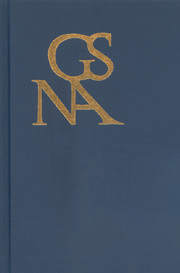Book contents
- Frontmatter
- Contents
- Towards a German Romantic Concept of the Ballad: Goethe's “Johanna Sebus” and Its Musical Interpretations by Zelter and Reichardt
- “Trübe” as the Source of New Color Formation in Goethe's Late Works Entoptische Farben (1817–20) and Chromatik (1822)
- The Myth of Otherness: Goethe on Presence
- The Transformation of the Law of Nations and the Reinvention of the Novella: Legal History and Literary Innovation from Boccaccio's Decameron to Goethe's Unterhaltungen deutscher Ausgewanderten
- “Hear him! hört ihn!”: Scholarly Lecturing in Berlin and the Popular Style of Karl Philipp Moritz
- Hypochondria, Onanism, and Reading in Goethe's Werther
- Judex! Blasphemy! and Posthumous Conversion: Schiller and (No) Religion
- Esoterik der “Macht, die über uns waltet und alles zum Besten lenkt”: Das Wissen vom Anderen in Goethes Wilhelm Meisters Lehrjahre
- Goethes Fortgepflanztes: Zur Unbegrifflichkeit der Morphologie
- Special Section on Die Entstehung der Neueren deutschen Literaturwissenschaft aus der Goethe-Philologie
- Book Reviews
The Myth of Otherness: Goethe on Presence
Published online by Cambridge University Press: 05 February 2013
- Frontmatter
- Contents
- Towards a German Romantic Concept of the Ballad: Goethe's “Johanna Sebus” and Its Musical Interpretations by Zelter and Reichardt
- “Trübe” as the Source of New Color Formation in Goethe's Late Works Entoptische Farben (1817–20) and Chromatik (1822)
- The Myth of Otherness: Goethe on Presence
- The Transformation of the Law of Nations and the Reinvention of the Novella: Legal History and Literary Innovation from Boccaccio's Decameron to Goethe's Unterhaltungen deutscher Ausgewanderten
- “Hear him! hört ihn!”: Scholarly Lecturing in Berlin and the Popular Style of Karl Philipp Moritz
- Hypochondria, Onanism, and Reading in Goethe's Werther
- Judex! Blasphemy! and Posthumous Conversion: Schiller and (No) Religion
- Esoterik der “Macht, die über uns waltet und alles zum Besten lenkt”: Das Wissen vom Anderen in Goethes Wilhelm Meisters Lehrjahre
- Goethes Fortgepflanztes: Zur Unbegrifflichkeit der Morphologie
- Special Section on Die Entstehung der Neueren deutschen Literaturwissenschaft aus der Goethe-Philologie
- Book Reviews
Summary
Western culture is dominated by representation—however, in 1993 in a series of essays, Jean-Luc Nancy counters this paradigm of all signification processes from a culturally critical perspective with a new paradigm, and proclaims “the birth to presence.” In the course of this paradigm shift from representation to presence and as a consequence of Hans Ulrich Gumbrecht's work, contemporary literary criticism has also taken an interest in “what meaning cannot convey.” Yet, to speak of a “new” paradigm implies a kind of mastery, since presence basically represents an outdated paradigm in two respects. In the hermeneutic tradition, whose roots are deeply grounded in the philosophical aesthetic of the nineteenth century, the concept was, first, used for the direct experience of meaning, most importantly in the realm of art. Second, as understood by poststructuralist thinkers—especially in the field of deconstruction—hermeneutics was then seen to be motivated by a disproportionate or even false desire for presence. Since the 1960s, in the wake of these investigation into representation, the paradigm fell into oblivion or even disrepute. Hermeneutics seemed to be a mode of engaging with texts that sought to secure the full presence of signification, a pleroma of meaning. In contrast, the emphasis among poststructuralists was on the dark stain of the signifier, the operation of the trope, the play of textual signs deferring any arrival at a fullness of meaning.
- Type
- Chapter
- Information
- Goethe Yearbook 19 , pp. 49 - 66Publisher: Boydell & BrewerPrint publication year: 2012

